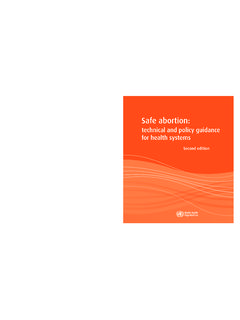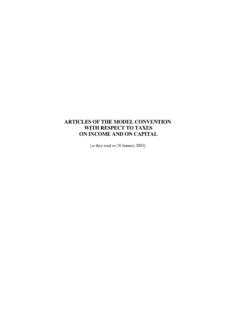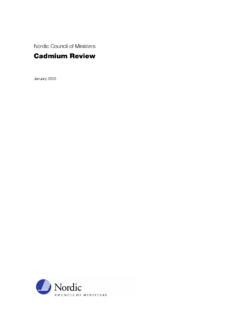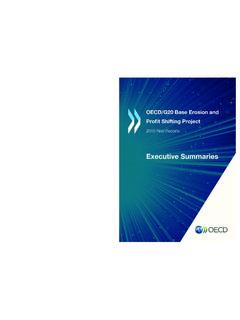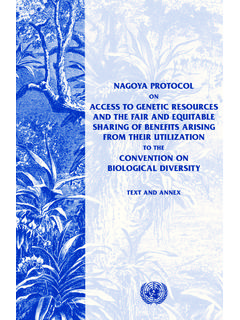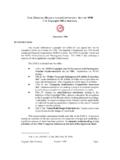Transcription of Sulphur Content in Marine Fuels - ECG
1 Sulphur Content in Marine Fuels Briefing Report January 2013. 1. Table of Contents Glossary .. 3. Historical background to MARPOL and IMO regulations .. 5. Current situation from IMO standpoint .. 8. Historical background on EU Directives .. 10. Current situation from EU standpoint .. 12. Future developments .. 13. Important deadlines and timeline .. 14. Useful links .. 16. 2. Glossary International Maritime Organisation (IMO): is the United Nations specialized agency with responsibility for the safety and security of shipping and the prevention of Marine pollution by ships. In 1948 an international conference in Geneva adopted a convention formally establishing IMO (the original name was the Inter-Governmental Maritime Consultative Organisation, or IMCO, but the name was changed in 1982 to IMO). IMO currently has 170 Member States and three Associate Members. Non-governmental international organisations that have the capability to make a substantial contribution to the work of IMO may be granted consultative status by the Council with the approval of 1.
2 The Assembly. At present 89 NGOs have Consultative status. IMO may enter into agreements of co- operation with other intergovernmental organisations on matters of common interest with a view to ensuring maximum co-ordination in respect of such matters. To date there are 61 intergovernmental 2. organisations which have signed agreements of co-operation with IMO. Marine Environment Protection Committee (MEPC): is one of the five main Committees of IMO and consists of all Member States; it is empowered to consider any matter within the scope of the Organisation concerned with prevention and control of pollution from ships. In particular it is concerned with the adoption and amendment of conventions and other regulations and measures to ensure their enforcement ( MARPOL). The MEPC was first established as a subsidiary body of the IMO's Assembly and raised to full constitutional status in 1985.
3 MARPOL ( Marine POLlution): means the International Convention for the Prevention of Pollution from Ships, 1973, as modified by the Protocol of 1978 relating thereto and by the Protocol of 1997. It currently includes six technical Annexes. To become a party to MARPOL, a state must accept Annex I. and II, as of today 152 states have ratified the first two annexes. Amendments of MARPOL are discussed and agreed upon by the MEPC. MARPOL Annex VI: annex added to MARPOL in 1997 to regulate air pollution from ships. Emission Control Area (ECA): MARPOL Annex VI, which entered into force in 2005, foresaw a specially designated sea area where the adoption of special mandatory measures for emissions from ships is required to prevent, reduce and control air pollution from NO x, SOx and/or particulate matter and their attendant adverse impacts on human health and the environment. In this regard we speak about a SOx Emission Control Area, SECA or a NO x Emission Control Area, NECA.
4 NOx (nitrogen oxides): NOx is a generic term for mono-nitrogen oxides No (nitric oxide) and NO 2. (nitrogen dioxide). They are produced from the reaction of nitrogen and oxygen gases in the air during 1. 2. 3. combustion, especially at high temperatures. SOx ( Sulphur oxides): Sulphur oxide refers to many types of Sulphur and oxygen containing compounds that can be found in ship exhaust gas. The most frequent Sulphur Content in ships emissions in Sulphur dioxide (SO2). The following definitions have been updated according to Directive 2012/33/EU as regards the Sulphur Content in Marine fuel : Heavy fuel oil (HFO): any petroleum-derived liquid fuel , excluding Marine fuel , falling within CN code 2710 19 51 to 2710 19 68, 2710 20 31, 2710 20 35, 2710 20 39, or any petroleum-derived liquid fuel , other than gas oil as defined in points 2 and 3, which, by reason of its distillation limits, falls within the category of heavy oils intended for use as fuel and of which less than 65% by volume (including losses) distils at 250 C by the ASTM D86 method.
5 If the distillation 3. cannot be determined by the ASTM D86 method , the petroleum product is likewise categorised as a heavy fuel oil. Gas oil: any petroleum-derived liquid fuel , excluding Marine fuel , falling within CN code 2710 19 25, 2710 19 29, 2710 19 47, 2710 19 48, 2710 20 17 or 2710 20 19, or any petroleum-derived liquid fuel , excluding Marine fuel , of which less than 65% by volume (including losses) distils at 250 C and of which at least 85% by volume (including losses) distils at 350 C by the ASTM D86 method. Marine fuel : any petroleum-derived liquid fuel intended for use or in use on board a vessel, including those Fuels defined in ISO 8217 (1996), in particular: Marine diesel oil: Marine diesel oil means any Marine fuel as defined for DMB grade in Table I of ISO. 8217 with the exception of the reference to the Sulphur Content ;. Marine gas oil (MGO): Marine gas oil means any Marine fuel as defined for DMX, DMA and DMZ.
6 Grades in Table I of ISO 8217 with the exception of the reference to the Sulphur Content ;. 3. ASTM method means the methods laid down by the American Society for Testing and Materials in the 1976. edition of standard definitions and specifications for petroleum and lubricating products. 4. Historical background to MARPOL and IMO regulations The International Convention for the Prevention of Pollution from Ships (MARPOL) is the main international convention covering prevention of pollution of the Marine environment by ships from either operational or accidental causes. It is a combination of two treaties adopted in 1973 and 1978. respectively and also includes the Protocol of 1997 (Annex VI). It has been updated by amendments through the years. The MARPOL Convention was adopted on 2 November 1973 at IMO and covered pollution by oil, chemicals, harmful substances in packaged form, sewage and garbage.
7 The Protocol of 1978 relating to the 1973 International Convention for the Prevention of Pollution from Ships (1978 MARPOL. Protocol) was adopted at the Conference on Tanker Safety and Pollution Prevention in February 1978. held in response to a spate of tanker accidents in 1976-1977. As the 1973 MARPOL Convention had not yet entered into force, the 1978 MARPOL Protocol absorbed the parent Convention. The combined instrument is referred to as the International Convention for the Prevention of Marine Pollution from Ships, 1973, as modified by the Protocol of 1978 relating thereto (MARPOL 73/78), and it entered into force on 2 October 1983 (Annexes I and II). In 1997 a new Protocol was adopted to add Annex VI. The Convention includes regulations aimed at preventing and minimizing pollution from ships - both accidental pollution and that from routine operations - and currently includes six technical Annexes.
8 Special areas with strict controls on operational discharges are included in most Annexes. To become a party to MARPOL a state must accept Annex I and II. Annexes III-VI are voluntary annexes. Annex I Regulations for the Prevention of Pollution by Oil (entered into force 2nd October 1983, ratified by 152 States/Parties). It covers prevention of pollution by oil from operational measures as well as from accidental discharges. The 1992 amendments to Annex I made it mandatory for new oil tankers to have double hulls and introduced a phase-in schedule for existing tankers to fit double hulls, which was subsequently revised in 2001 and 2003. Annex II Regulations for the Control of Pollution by Noxious Liquid Substances in Bulk (entered into force 2nd October 1983, ratified by 152 States/Parties). Annex II details the discharge criteria and measures for the control of pollution by noxious liquid substances carried in bulk.
9 Some 250 substances were evaluated and included in the list appended to the Convention. The discharge of their residues is allowed only to reception facilities when certain concentrations and conditions (which vary with the category of substances) are complied with. 5. In any case, no discharge of residues containing noxious substances is permitted within 12 miles of the nearest land. More stringent restrictions apply to the Baltic and Black Sea areas. Annex III Prevention of Pollution by Harmful Substances Carried by Sea in Packaged Form (entered into force 1st July 1992, ratified by 138 States/Parties). Annex III contains general requirements for the issuing of detailed standards on packing, marking, labelling, documentation, stowage, quantity limitations, exceptions and notifications for preventing pollution by harmful substances. The International Maritime Dangerous Goods (IMDG) Code has, since 1991, included Marine pollutants.
10 Annex IV Prevention of Pollution by Sewage from Ships (entered into force 27 September 2003, ratified by 131 States/Parties). Annex IV contains requirements to control pollution of the sea by sewage. Annex V Prevention of Pollution by Garbage from Ships (entered into force 31st December 1988, ratified by 144 States/Parties). This deals with different types of garbage and specifies the distances from land and the manner in which they may be disposed of. The requirements are much stricter in a number of "special areas" but perhaps the most important feature of the Annex is the complete ban imposed on the dumping into the sea of all forms of plastic. Annex VI Prevention of Air Pollution from Ships (entered into force 19th May 2005, ratified by 75. States/Parties). The regulations in this annex set limits on SOx and NOx emissions from ship exhausts, as well as particulate matter, and prohibit deliberate emissions of ozone depleting substances.
